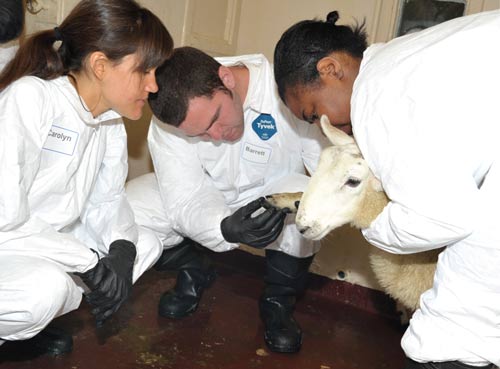Training in foreign diseases opens students’ eyes
Veterinary student Ashley Hagauer went into veterinary college knowing she wanted to explore career options in public health and regulatory veterinary medicine. Participating in the Smith-Kilborne Program helped persuade her to keep following that path.
Veterinary Services within the Department of Agriculture’s Animal and Plant Health Inspection Service puts on the Smith-Kilborne Program annually to acquaint veterinary students with foreign animal diseases. APHIS offers the program in conjunction with training for veterinarians in government and academia to become FAD diagnosticians.

A key component of the program is spending time at the Plum Island Animal Disease Center at Plum Island, New York. Training includes working with animals that have been experimentally infected for instructional purposes with organisms that cause diseases such as foot-and-mouth disease.
Training program
The Smith-Kilborne Program began in the 1990s entirely at Plum Island. The course takes its name from Theobald Smith, MD, and Dr. Fred Kilborne, who collaborated with Dr. Cooper Curtice on the discovery that ticks are the vectors for the protozoan that causes Texas cattle fever.
After a lapse, the course started up again in 2003 as a two-part class. Students spend three days on the mainland learning about foreign animal diseases, epidemiology, and public health. Then they spend two days at Plum Island. The first part of the course was at Cornell University until this year, when it moved to APHIS headquarters in Maryland.
Dr. Jason Baldwin, an APHIS training specialist and coordinator of the Smith-Kilborne Program, said the course emphasizes the impact of foreign animal diseases more than their diagnosis.
“We want the students to understand what those diseases are and why they’re a threat to our country, what we would do if we had an outbreak in this country,” Dr. Baldwin said. “We teach them emergency management and incident command system, give them a chance to practice.”
The course incorporates topics such as communicating with the public; the roles of international health agencies; and the one-health concept that animal, human, and environmental health are interconnected.
At Plum Island, veterinary students in the Smith-Kilborne Program join veterinarians training to be FAD diagnosticians for part of the veterinarians’ two-week course. The students see animals that have FMD, exotic Newcastle disease, and African horse sickness. They conduct necropsies of chickens with END.

“I’ve had students, years after the program, tell me that they’ve never forgotten going into the lab and seeing foot-and-mouth with their own two eyes,” Dr. Baldwin said. “They understand the importance of being able to see these diseases and recognize them early.”
Each U.S. veterinary college selects one second-year student for the Smith-Kilborne Program, which takes place just after Memorial Day every year. APHIS covers expenses. The governments of Canada and Mexico cover airfare for each country to send one veterinary student. On returning to school, each student gives a presentation.
Most participants in the program have an interest in public health or regulatory veterinary medicine or have worked or traveled internationally.
“Some students come in thinking they are small animal–focused, and then they leave with a different viewpoint of what regulatory veterinarians do,” Dr. Baldwin said. “That’s one of the other goals, too, to expose the students to the variety of careers in veterinary medicine.”
Participants have gone on to careers with the USDA, state agencies, and the military. Some have even gone on to work at Plum Island.
Student experience
Hagauer, who is a fourth-year veterinary student at Texas A&M University, said her interest in public health and regulatory veterinary medicine stems from a desire to have a broad impact on health. In 2013, she participated in the Smith-Kilborne Program.
The classroom work was enjoyable, Hagauer said. Students worked in groups on scenarios in outbreak and disaster response. Veterinarians spoke about their experiences responding to outbreaks of diseases such as highly pathogenic avian influenza.
At Plum Island, Hagauer found that seeing pictures is not the same as seeing the clinical signs of a foreign animal disease in person.
“You really don’t understand until you see it in front of you,” she said. “I finally felt connected to those diseases.”
Hagauer did not realize how many opportunities there are for veterinarians with the USDA until she participated in the Smith-Kilborne Program. She went on to an externship with APHIS Veterinary Services earlier this year at the Center for Epidemiology and Animal Health in Fort Collins, Colorado. While there, she went out in the field with an FAD diagnostician responding to the recent outbreak of vesicular stomatitis.
After earning her veterinary degree, Hagauer hopes to earn a master’s degree in public health or complete a residency in veterinary preventive medicine.
Hagauer said the training at Plum Island was one of her best experiences as a veterinary student. The course made her realize that she still wants to go in the direction of public health and regulatory veterinary medicine for her career.
“It was eye-opening,” she said. “I feel like I got to see the ocean. You can talk about what the ocean looks like ... but you >have to actually experience it.”